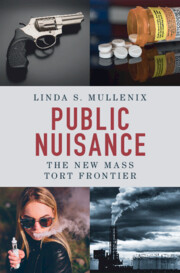Book contents
- Public Nuisance
- Public Nuisance
- Copyright page
- Dedication
- Contents
- Acknowledgements
- Introduction
- 1 Historical Context of Private and Public Nuisance at Law and Equity
- 2 Shifting Mass Tort Theories in the 1990s and the Judicial Resistance to the Expansion of Public Nuisance Liability
- 3 Expanding Public Nuisance Doctrine
- 4 Litigating Public Nuisance Claims
- 5 Expanding Public Nuisance Doctrine: Defenses
- 6 Expanding Public Nuisance
- 7 Environmental Contamination, PCBs, and Climate Change as Public Nuisance Harms
- 8 Opioids as Public Nuisance Health and Welfare Harm
- 9 Firearms Violence as a Public Nuisance
- 10 E-Cigarettes and Vaping as a Public Nuisance Harm
- 11 Evaluating the Competing Arguments Regarding the Contemporary Use of Public Nuisance in Mass Tort Litigation
- Conclusion
- Index
11 - Evaluating the Competing Arguments Regarding the Contemporary Use of Public Nuisance in Mass Tort Litigation
Published online by Cambridge University Press: 02 November 2023
- Public Nuisance
- Public Nuisance
- Copyright page
- Dedication
- Contents
- Acknowledgements
- Introduction
- 1 Historical Context of Private and Public Nuisance at Law and Equity
- 2 Shifting Mass Tort Theories in the 1990s and the Judicial Resistance to the Expansion of Public Nuisance Liability
- 3 Expanding Public Nuisance Doctrine
- 4 Litigating Public Nuisance Claims
- 5 Expanding Public Nuisance Doctrine: Defenses
- 6 Expanding Public Nuisance
- 7 Environmental Contamination, PCBs, and Climate Change as Public Nuisance Harms
- 8 Opioids as Public Nuisance Health and Welfare Harm
- 9 Firearms Violence as a Public Nuisance
- 10 E-Cigarettes and Vaping as a Public Nuisance Harm
- 11 Evaluating the Competing Arguments Regarding the Contemporary Use of Public Nuisance in Mass Tort Litigation
- Conclusion
- Index
Summary
Chapter 11 turns to a discussion of the competing arguments concerning the new public nuisance law advanced by practicing attorneys, interest group allies, judges, scholars, and law-and-economics professors. Almost all criticisms of the new public nuisance law have been negative, characterizing expansion of public nuisance law as illegitimate and dysfunctional. These critiques are examined through the lens of various categories of criticism: (1) traditional, (2) formal, (3) institutional, (4) rule of law, (5) democratic theory, and (5) law and economics. The critics all draw on negative examples from the mass tort public nuisance cases in the 21st century (lead paint, firearms, opioids, vaping, climate change). At least one commentator, however, has offered tempered praise for the new public nuisance law as the second best solution to community-wide harms. She believes that the development of the new public nuisance law is in the finest traditon of a flexible, developing common law to meet changed circumsatnces. This commentator would permit continued development of the new public nuisance law, enhanced with several guardrails and transparency in proceedings.
Keywords
- Type
- Chapter
- Information
- Public NuisanceThe New Mass Tort Frontier, pp. 230 - 257Publisher: Cambridge University PressPrint publication year: 2023

